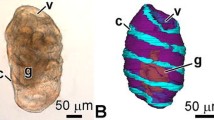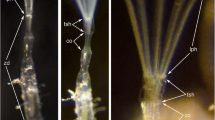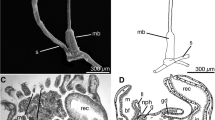Abstract
The formation of the definitive excretory system (nephridium and bladder complex) in Hirudo medicinalis during the last two thirds of embryonic development was observed with light- and electron microscopy, immunocytochemistry, and nuclear labeling. In jawed leeches, two excretory systems develop and function successively. The nephridia of the cryptolarva are associated with the larval sac and persist until the definitive nephridia are sufficiently developed to be functional. Development of the definitive excretory system begins with the differentiation of the (ectodermal) bladder and urethra. The cells from which they arise incorporate bacteria and are thereby recognizable at day 8. The (mesodermal) urine-forming tissues of the nephridium (canalicular cells and central canal cells) appear a day later. By day 17, the nephridia are in contact with the outlet region and structurally able to function. Each nephridium is individually innervated by a peripheral neuron, the nephridial nerve cell, which expresses FMR Famide-like immunoreactivity and begins growing into the nephridium on day 11. Organogenesis of the leech nephridium is compared with the formation of excretory organs in other species. The temporal correlation of innervation and the development of the transporting cells is discussed.
Similar content being viewed by others
References
Baptista CA, Macagno ER (1988) Modulation of the pattern of axonal projections of a leech motor neuron by ablation or transplantation of its target. Neuron 1:949–962
Boroffka I, Hamp W (1969) Topographic des Kreislaufsystems und der Zirkulation bei Hirudo medicinalis. Z Morphol Tiere 64:59–76
Braun J, Stent GS (1989a) Axon outgrowth along segmental nerves in the leech. I. Identification of candidate guidance cells. Dev Biol 132:471–485
Braun J, Stent GS (1989b) Axon outgrowth along segmental nerves in the leech. II. Identification of actual guidance cells. Dev Biol 132:486–501
Büsing KH, Döll W, Freytag K (1953) Die Bakterienflora des medizinischen Blutegels. Arch Microbiol 19:52–86
Dircksen H, Müller A, Keller R (1991) Crustacean cardioactive peptide in the nervous system of the Locust, Locusta migratoria: an immunocytochemical study on the ventral nerve cord and peripheral innervation. Cell Tissue Res 263:439–457
Fernandez J, Stent GS (1982) Embryonic development of the hirudinid leech Hirudo medicinalis: structure, development and segmentation of the germinal plate. J Embryol Exp Morph 72:71–96
Gratzner HG (1982) Monoclonal antibody to 5-bromo and 5-iododeoxy-uridine: a new reagent for detection of DNA replication. Science 218:474–475
Hoeger U, Wenning A, Greisinger U (1989) Ion homeostasis in the leech: contribution of organic anions. J Exp Biol 147:43–51
Jellies J (1990) Muscle assembly in simple systems. TINS 13:126–131
Jellies J, Kopp DM, Bledsoe JW (1992) Development of segment-and target-related neuronal identity in the medicinal leech. J Exp Biol 170:71–92
Kuhlmann JR, Li C, Calabrese RL (1985) FMRF-amide-like Substances in the leech. I. Immunocytochemical localization. J Neurosci 5:2301–2309
Kuwada JY (1985) Pioneering and pathfinding by an identified neuron in the embryonic leech. J Embryol Exp Morphol 86:155–167
Macagno ER, Gao WQ, Baptista CA, Passani MB (1990) Competition or inhibition? Developmental strategies in the establishment of peripheral projections by leech neurons. J Neurobiol 21:107–119
Maddrell SHP, Lane NJ, Harrison JB, Gardiner BOC (1985) DNA replication in binucleate cells of the Malpighian tubules of Hemipteran insects. Chromosoma (Berl) 91:201–209
Maranto A, Calabrese RL (1984) Neural control of the hearts in the leech, Hirudo medicinalis. I. Anatomy, electrical coupling, and innervation of the hearts. J Comp Physiol [A] 154:357–380
Marder E, Calabrese RL, Nusbaum MP, Trimmer B (1987) Distribution and partial characterization of FMRFamide-like peptides in the stomatogastric nervous system of the rock crab, Panulirus interruptus. J Comp Neurol 259:150–163
Martindale MQ, Shankland M (1988) Developmental origin of segmental differences in the leech ectoderm: survival and differentiation of the distal tubule cell is determined by the host segment. Dev Biol 125:290–300
McGlade-McCulloh E, Muller KJ, Zipser B (1990) Expression of Surface glycoproteins early in leech neural development. J Comp Neurol 299:123–131
Muller KJ, Nicholls JG, Stent GS (eds) (1981) Neurobiology of the leech. Cold Spring Harbor Laboratory, Cold Spring Harbor, New York
Sandig M, Dohle W (1988) The cleavage pattern in the leech Theromyzon tessulatum (Hirudinea, glossiphoniidae). J Morphol 196:217–252
Saxén L (1987) Organogenesis of the kidney. Cambridge University Press, Cambridge
Shankland M (1987) Differentiation of O and P cell lines in the embryo of the leech. I. Sequential commitment of blast cell sublineages. Dev Biol 123:85–96
Shankland M (1991) Leech segmentation: Cell lineage and the formation of complex body patterns. Dev Biol 144:221–234
Shankland M, Weisblat DA (1984) Stepwise commitment of blast cell fates during the positional specification of the O and P cell lines in the leech embryo. Dev Biol 106:326–342
Skaer H (1989) Cell division in Malpighian tubule development in D. melanogaster is regulated by a single tip cell. Nature 342:566–568
Skaer H (1992) Cell proliferation and rearrangement in the development of Malpighian tubules of the Hemipteran, Rhodnius prolixus. Dev Biol 150:372–380
Stewart RR, Gao WQ, Macagno ER (1991) Segmental differentiation in the leech central nervous system: proposed segmental homologs of heart accessory neurons. J Comp Neurol 313:431–440
Sternberger L (1979) Immunocytochemistry, 2nd edn. Wiley, New York
Truman JW, Bate M (1988) Spatial and temporal patterns of neurogenesis in the central nervous system of Drosophila melanogaster. Dev Biol 125:145–157
Weisblat DA, Sawyer RT, Stent GS (1978) Cell lineage analysis by intracellular injection of a tracer enzyme. Science 202:1295–1298
Weisblat DA, Price DJ, Wedeen CJ (1988) Segmentation in leech development. Development 104 [Suppl]:161–168
Wenning A (1987) Salt and water regulation in Macrobdella decora (Hirudinea: Gnathobdelliformes) under osmotic stress. J Exp Biol 131:337–349
Wenning A (1989) Properties of a set of internal receptors in the medicinal leech: the nephridial nerve cells monitor extracellular chloride concentration. J Exp Biol 143:115–132
Wenning A, Cahill MA (1986) Nephridial innervation in the leech, Hirudo medicinalis L. Cell Tissue Res 245:397–404
Wenning A, Cahill MA (1989) Structural and ultrastructural features of the inlet and outlet regions of the urinary bladders of the leech, Hirudo medicinalis. J Morphol 201:285–291
Wenning A, Calabrese RL (1991) Mechanism of Cl− sensitivity in internal ion receptors of the leech: an inward current gated off by Cl− in the nephridial nerve cells. J Comp Physiol [A] 168:53–61
Wenning A, Cahill MA, Hoeger U, Calabrese RL (1993) Sensory and neurosecretory innervation of leech nephridia is accomplished by a single neurone containing FMRFamide. J Exp Biol (in press)
Wenning A, Kaltenhäuser U, Greisinger U, Hoeger U (1992) Afferent and efferent innervation of leech nephridia occurs by a single identified neuron expressing FMRF-NH2-like immunoreactivity. Soc Neurosc Abstr 18:267
Wilkin JP, Scofield M (1991) Growth of the medicinal Leech. Freshwater Biology 25:537–553
Zerbst-Boroffka I (1975) Function and ultrastructure of the nephridium in Hirudo medicinalis L. III. Mechanisms of the formation of primary and final urine. J Comp Physiol 100:307–315
Zerbst-Boroffka I, Wenning A (1986) Mechanisms of regulatory salt and water excretion in the leech, Hirudo medicinalis L. Zool Beitr NF 30:359–377
Zipser B (1979) Identifiable neurons controlling penile eversion in the leech. J Neurophysiol 42:455–464
Author information
Authors and Affiliations
Additional information
Correspondence to: A. Wenning
Rights and permissions
About this article
Cite this article
Wenning, A., Cahill, M.A., Greisinger, U. et al. Organogenesis in the leech: development of nephridia, bladders and their innervation. Roux's Arch Dev Biol 202, 329–340 (1993). https://doi.org/10.1007/BF00188732
Received:
Accepted:
Issue Date:
DOI: https://doi.org/10.1007/BF00188732




